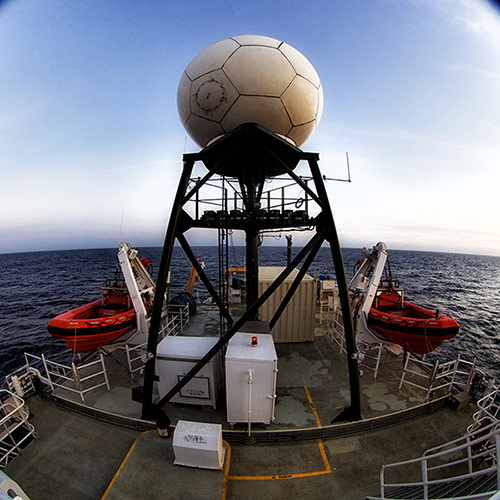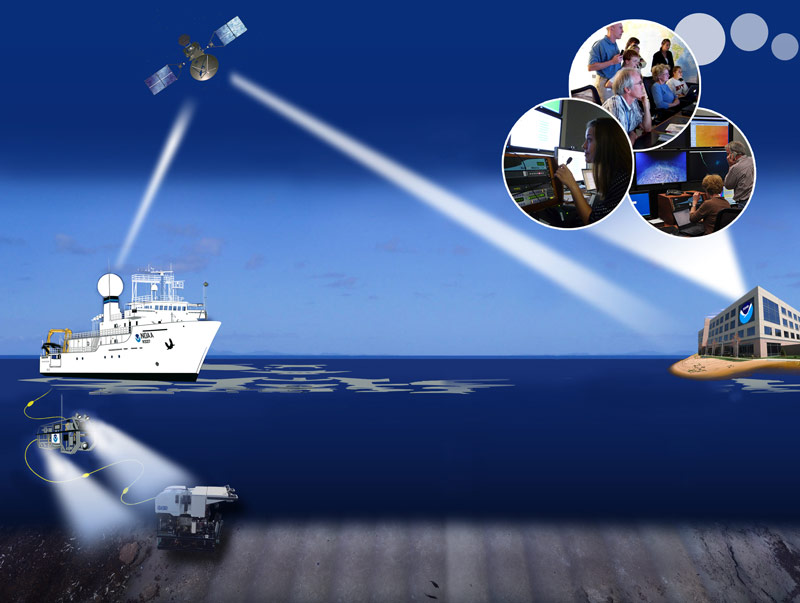
By Brian RC Kennedy, Telepresence Lead and Expedition Coordinator, NOAA Office of Ocean Exploration and Research
August 2, 2016

The VSAT (large dome; stands for “Very Small Aperture Terminal”) is the critical piece of infrastructure that makes telepresence possible. Image courtesy of the NOAA Office of Ocean Exploration and Research, Deepwater Wonders of Wake. Download larger version (jpg, 4 MB).
As you sit at home or at your office watching the live video from NOAA Ship Okeanos Explorer, you are seeing information between 2.5 to 30 seconds after it is captured by the remotely operated vehicle (ROV). So just think about that.
The closest point of land to the ship right now is Wake Atoll, which is truly in the in middle of nowhere. So, we are completely dependent on satellite telecommunication for our connection to the rest of humanity. In order to get the images recorded on the seafloor to your screen, those images have been encoded transformed, re-encoded, retransmitted, and decoded numerous times during their 50-something thousand-mile journey from the seafloor to your eyes.

This diagram illustrates the flow of information from the seafloor and ultimately to viewers around the world. Image courtesy of the NOAA Office of Ocean Exploration and Research, Deepwater Wonders of Wake. Download larger version (jpg, 1.8 MB).
The seafloor at the depth we are working receives no surface light, so we have to bring our own. ROV Deep Discoverer (D2) produces light in order for the cameras to “see” the area around the ROV. Let’s follow, in simplified terms, the path the information revealed by one photon produced by D2.
D2 converts electricity into light and sends the photon out into the water, where it hits the coral the ROV is “looking” at. The photo is then reflected off the coral, and that reflected photon changes wavelength due to the pigment or refraction of the coral giving it the effect of what we would call a color.
Then the camera on D2 receives the photo and encodes the information contained on that photon into an electrical current. That electrical current is turned into a digital signal (think ones and zeros/bytes and bits), which is also carried on electrical signals. These signals are moved from the camera to the electronics bottle on D2, which is about three feet away from the camera.
The electrical ones and zeros that describe the photo captured by the camera are converted back into photons of light. Using a laser, we shoot the “information” (still ones and zeros) up the eight-kilometer cable that connects D2 to the Okeanos Explorer. That eight-kilometer trip takes about 0.00003 seconds.
Once those photons are received on the ship, the information they carry is converted back into an electrical signal which flows over copper cables around the ship until it reaches the video encoders. The encoders take the digital video signal that is contained in the electrical signal and converts that information in to IP (Internet Protocol)-based video. This is the language of the Internet.
Now the information is ready to be sent out on the Internet to viewers around the world – but first we have to get it off the ship. The encoder sends the new IP-based video out on Ethernet cables to the satellite modem where the electrical ones and zeros are taken from the cable and the information is encoded on a radio wave. The radio wave is then amplified several times and transmitted to a geosynchronous satellite that is about 22,000 miles above the Earth’s surface.
The satellite receives the signal and then rebroadcasts it back to Earth. We have another modem in what is called an Earth Station in southern California that listens for the radio signals from the satellite. That modem takes the information in the radio waves and converts it back to an electrical signal. So far all of this has taken about a second.
After the electrical signal leaves the teleport, the information flows from southern California to Silver Spring, Maryland, on a dedicated connection. Once it reaches the NOAA network operation center (NOAA NOC), the traffic is handed off to Internet 2, which is a special high bandwidth Internet that is run and maintained by universities across the country.
At this point anyone with an Internet 2 connection can view the video with about a 2.5-second delay. For those of you not luckily enough to have an Internet 2 connection, there are a few more steps before you get the see the video. The Inner Space Center at the University of Rhode Island takes the video off Internet 2 and transcodes it to a different type of IP-based video that will work on the standard Internet and then sends that signal to YouTube.
When you open your web browser and hit play on the video window, your computer sends a request to YouTube for their servers to send a copy of the video to your computer. Once your machine receives the signal from YouTube, it converts the signal one last time from the electrical signal your computer received into photons that come from your screen into your eye. All of this takes about 20-30 seconds, depending on where you are.
So after more than 50,000 miles of travel in less than 30 seconds, the information from the bottom of the seafloor has been converted from photon to electron, back to photon, back to an electron, then to a radio wave, then back to an electron when it reaches your computer. Then finally your computer uses the “information” that was encoded on all these different signals to create one last photon that represents one pixel of your screen that is transmitted to your eye. This photon is the same wave length and a similar intensity as the original photon that was captured 30 seconds ago (2.5 seconds on Internet 2) in the middle of nowhere on the bottom of the ocean.